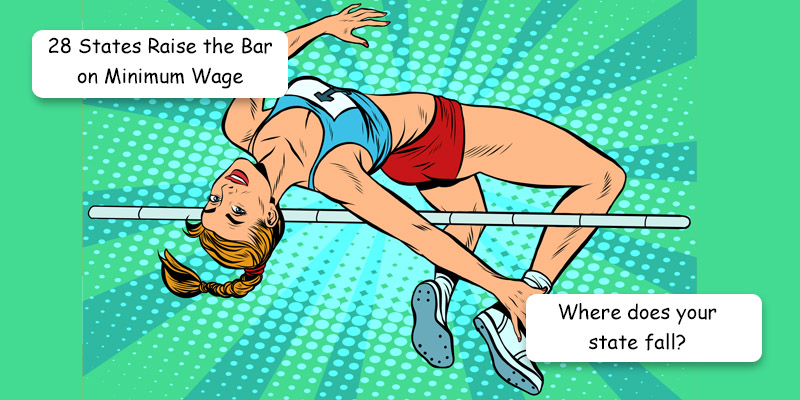While the Federal minimum wage remains at $7.25 per hour for the past 15 years, 28 states and many cities, counties and locals have set increases effective January 1st, 2024 with a few announcing a change during 2024. Many states continue their path to $15.00 per hour with a number of states exceeding that rate and places in Washington state that have a minimum wage approaching $20 per hour. A list of each state/local, along with the new hourly rate is listed below. Any state that does not have a minimum wage change scheduled is not listed.
All rates are effective January 1st, 2024 unless otherwise noted.
- Alaska: $11.73
- Arizona: $14.35 ($11.35 for tipped employees)
- Flagstaff: $17.40 ($15.90 for tipped employees)
- California: $16.00
- $20.00 for fast food workers of chains of 60 or more locations. 4/1/2024 Food chains in California who make their own bread, like Panera Bread and Subway, are not subject.
- $18.00-$23.00 for health care workers based on employer type. 6/1/2024
- Oakland: $16.50
- San Diego: $16.85
- San Jose: $17.55
- Colorado: $14.42 ($11.40 for tipped employees)
- Denver: $18.29 ($14.27 for tipped employees)
- Connecticut: $15.69
- Delaware: $13.25
- Florida: $13.00 ($9.98 for tipped employees) 9/30/2024
- Hawaii: $14.00
- Illinois: $14.00 ($8.40 for tipped employees)
- Maine: $14.15 ($7.08 for tipped employees)
- Portland: $15.00 ($7.50 for tipped employees)
- Rockland: $15.00
- Maryland: $15.00
- Massachusetts: $16.25
- Michigan: $10.33 for employees 18 & over ($3.93 for tipped employees)
- $8.78 for 16 & 17 year old employees
- Minnesota: $10.85 for businesses with annual gross revenue of $500,000 or more; $8.85 for businesses with annual gross revenue of less than $500,000
- Minneapolis: $15.57 for businesses with 101 or more employees (1/1/2024); $15.57 for businesses with 100 or fewer employees (7/1/2024)
- St. Paul: $15.57 for businesses with 10,001 or more employees; $15.57 for businesses with 101 to 10,000 employees (7/1/2024), $14.00 for businesses with 6 to 100 employees (7/1/2024), and $12.25 for businesses with five or fewer employees (7/1/2024).
- Missouri: $12.30 ($6.15 for tipped employees)
- Montana: $10.30
- Nebraska: $11.00 (7/1/2024) for businesses offering qualified health insurance benefits, $12.00 for employers that do not
- Nevada: $12.00 Two tier minimum wage system eliminated and replaced with a single rate. (7/1/2024)
- New Jersey: $15.13; $13.73 for seasonal or less than 6 employees ($5.26 for tipped employees)
- New Mexico: $12.00 ($3.00 for tipped employees)
- Las Cruces: $12.36, $4.95 for tipped employees
- New York: $15.00 (12/31/2023)
- NYC: $16.00
- Long Island & Westchester: $16.00
- Ohio: $10.45 food large employers ($5.05 for tipped employees); $7.25 for small employers with gross receipts of less that $385,000
- Oregon: $15.95 per hour inside the Portland urban growth boundary, $13.70 per hour in nonurban counties, and $14.70 in other areas of the state (7/1/2024)
- Puerto Rico: $10.50 (7/1/2024)
- Rhode Island: $14.00
- South Dakota: $11.20 ($5.60 for tipped employees)
- Vermont: $13.67 ($6.84 for tipped employees)
- Washington (state): $16.28
- Seattle: $19.97 for businesses with 501 or more employees; $19.97 for businesses with 500 or fewer employees that do not offer health insurance; $17.25 for businesses with 500 or fewer employees that do offer health insurance
- SeaTac: $19.71
A question we are often asked is in regards to the timing of the rate change. A rate change takes place on January 1st, means that it is for work performed on or after that date. It is not based on the date the wages are paid. For example, if your biweekly pay period is from 12/18/2023 to 12/31/2023, with a check date of January 5, 2024, all of those hours worked would be paid at the 2023 rate, even though it is being paid in 2024. A situation occurs when your pay period straddles two different calendar years, and a few days needs to be paid at the old rate and a few days at the new. This may cause a nightmare of work if your timekeeping/payroll system cannot handle assigning rates based on the day worked. The easiest solution would be to pay the entire pay period at the new rate. Yes, one may see this as ‘overpaying’ the employees, but in most cases the added administrative work involved may overshadow the additional wages paid. With PayMaster HCM time & labor and payroll, rates are assigned on a daily basis, so mid-pay period rate changes are never an issue.
The following 20 states are all remaining at the Federal minimum wage level of $7.25 for any FLSA subject employers. They either have no minimum rate set, or it is lower than the federal $7.25 rate. A rate that has been in place since July 24th, 2009. Alabama, Georgia, Idaho, Indiana, Iowa, Kansas, Kentucky, Louisiana, Mississippi, New Hampshire, North Carolina, North Dakota, Oklahoma, Pennsylvania, South Carolina, Tennessee, Texas, Utah, Wisconsin, Wyoming.
A final note. If your state has enacted a rate change, this means that you will need to update your state labor poster.
If your state is not listed, check with your state’s department of labor to confirm there was no rate change for 2024. The data listed is for general informational purposes only and should not be used as legal or professional advice. Please contact your state and local agency for more information regarding your State Minimum Wage as well as any exceptions that may exist.

